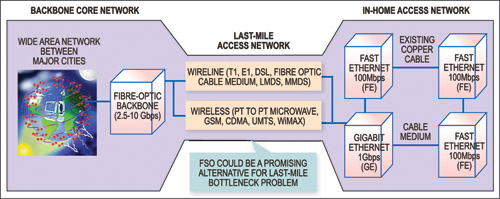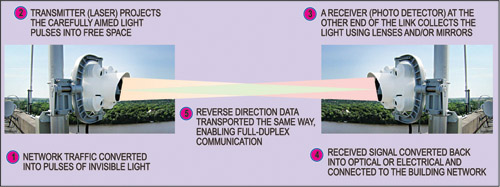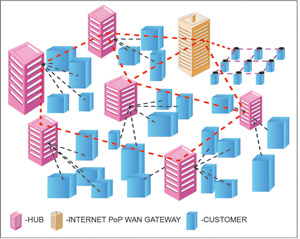Despite the availability of high-speed telecommunication facilities in the neighbourhood of last-mile locations such as business centres, offices and homes, there are still some technological constraints that hinder high-bandwidth availability. Moreover, wide area network (WAN) between major cities is fibre based and extremely fast (>2.5Gbps). Local area network (LAN) in buildings is also fast (>100Mbps). Most of these businesses run high-speed data networks within their buildings, such as fast Ethernet (100Mbps) or gigabit Ethernet (1Gbps). But the connections in between access networks are typically a lot slower (64kbps-14Mbps), whether they are wired or wireless (Fig. 1).

Wireless access network has its constraints such as electromagnetic interference (EMI)/electromagnetic compatibility (EMC) problems, atmospheric attenuation, hazardous electromagnetic radiation and limited throughput, scarcity of frequency spectrum availability.
Wire-line connections using copper lines—such as xDSL (digital subscriber line) (8Mbps), T-1 (1.544Mbps), E1 (2Mbps) and cable modem (5Mbps shared)—have speed and/or reach limitations. Although fibre-optic solution—for example, synchronous transport module, say (STM1) (155.52Mbps), STM4 (622.08Mbps), STM16 (2588.32Mbps), STM64 (9953.28Mbps)—could be a very attractive option for providing high-speed connectivity, till date only five per cent buildings are lit up with fibre-optics due to huge cost and time involved in taking permission, digging, trenching and laying these cables under existing streets, sidewalks, lawns, buildings, etc.
Security is for the most part non-existent on these connections and is dependent upon preventing physical access to the cabling. But if such high-speed connectivity could be served through some other viable telecommunication technology, there would be no need to build a new infrastructure for last-mile access. This is possible through free-space optics (FSO) technology.
What is free-space optics
Free-space optics is a high-bandwidth cost-effective solution to the last-mile problem. It is a wireless, point-to-point (PTP), fibreless, laser-driven and line-of-sight optical communication technology that uses invisible light propagating in free space to transmit information. FSO can transmit data, voice and video simultaneously through the air at speeds capable of reaching 1.25Gbps at a distance of 6.4 km (four miles) in full-duplex mode—enabling fibre-optic connectivity without requiring a physical fibre-optic cable.
FSO was originally developed by US military and NASA, and is currently being used for more than three decades in various forms to provide fast communication links. With the technological advancement in optical technology, tracking mechanism, implementation of dense wavelength division multiplexing (DWDM) kind of technologies, fourth-generation FSO systems capable of offering speeds up to 10Gbps are expected to hit the markets.
How it works
FSO is a line-of-sight technology that uses a pair of FSO units consisting of an optical transceiver with a laser (transmitter) and a photo detector (receiver) to provide full-duplex (bi-directional) capability between two points—without the fibre.

The transmitters can be either light emitting diodes (LEDs) (single or multiple), typically 1mW, or lasers (single or multiple), typically 10-100mW. The detectors can be positive-intrinsic-negative (PIN) diodes with –43dBm or advanced photodiode (APD) with –53dBm as minimum received power. These transceivers are mounted on rooftops, walls or even windows of buildings pointing at each other (Fig. 2). FSO systems use low-powered invisible infrared laser light of wavelengths in the 750nm to 1550nm range.

Key characteristics
FSO system deployment is surprisingly simple, and its link can be installed and aligned in less than an hour. Full installation takes no more than half a day. So, FSO can be used in disaster management and emergency conditions. These systems employ powerful lasers that can transmit through glass and windows, thus further increasing installation options and equipment security. FSO technology solves last-mile bottlenecks in hours, not weeks—and without digging or infrastructure upgrades required by other PTP connections because it does not require expensive fibre-optic cable or regulatory spectrum licences for radio-frequency (RF) solutions. Thus, it offers a fast and high return on investment.
Free-space optical spectrum is nearly unlimited, thus very dense frequency re-use is possible that makes very convenient deployment of FSO systems worldwide. Also, FSO communication is immune to radiofrequency interference or saturation. FSO technology provides fibre-like availability with data rates up to 1.25Gbps (expandable up to 10Gbps) that does so with the low latency, low jitter, low bit error-rate connections.







